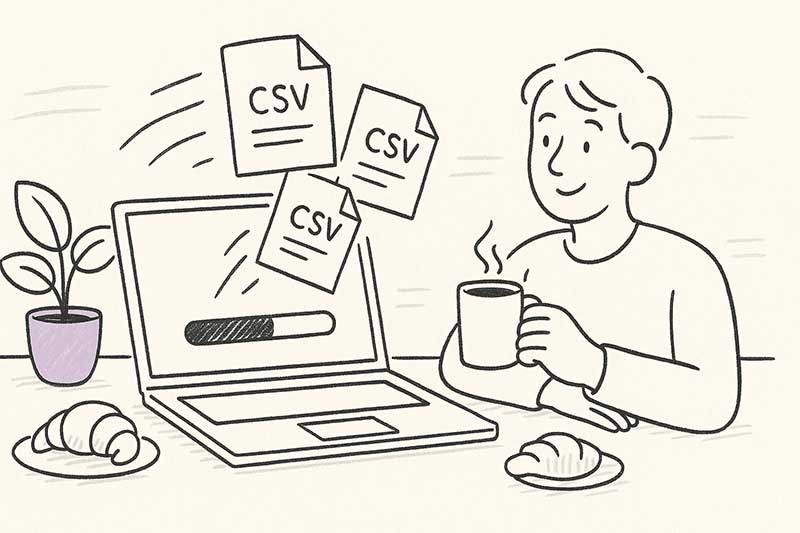Pretotyping Data Projects
Test Ideas Fast Before You Over Engineer Them
Why speed matters in data projects
Most data projects start with good intentions but lose momentum. Teams plan for perfect data models, long data pipelines and detailed dashboards, yet months later little has changed in how decisions are made. The business loses interest before results appear.
That’s where pretotyping helps. Instead of spending months building the full solution, you test the idea first. You make a small version that answers one question fast. If it works and sparks interest, you keep going. If not, you’ve lost little time or money.
This method is common in product design but works just as well in data and analytics. Before you invest in warehouses or automation, check if your idea solves a real problem.
Watch an example on how to test ideas fast
The video shows how to test ideas quickly without a big budget or long timeline. Focus on the core of your idea, build a simple version, and collect user feedback before scaling.
In this article, we’ll apply that mindset to data projects. You’ll see how to test ideas in days, avoid complexity, and build data tools people actually use.
What is Pretotyping?
Pretotyping means testing ideas before you fully build them. The term was coined by Alberto Savoia at Google and means “pretend before you prototype.” Instead of spending time and money creating a full system, you make a quick version to see if the idea is worth pursuing.
The goal is simple:
Build the right thing before you build the thing right.
You simulate parts of your solution just enough to see if it adds value. In a data project, that might be a small Power BI dashboard with sample data or even a static Excel mock-up to test if it’s useful.
Pretotyping isn’t about cutting corners. It’s about learning fast. You test assumptions, observe reactions and decide whether to continue, adjust or stop. That saves resources and keeps focus on solving real business needs.
Data teams often become too technical too soon. They discuss data models, storage or ETL pipelines before checking if anyone needs the result. Pretotyping flips that order. Start with the question, test fast and only then scale.
Some level of failure is part of the process. Test and learn fast. Iterate and improve. It's not about getting it 100% right the first time. It's about gathering feedback as soon as possible and getting everybody involved in the process.
Why traditional data projects slow you down
Many companies start their data journey with energy but lose speed in planning. Teams spend months defining models, cleaning every column and debating tools. When the first dashboard appears, the question has changed.
Traditional data projects aim for completeness instead of learning. Everything must be perfect before showing results. That works for infrastructure but not for analytics, where needs change often.
Common traps:
Perfect data. Progress stops because some fields are missing. Go for good enough data to test the idea.
Building before asking. Projects start without confirming if anyone will use the output.
Tech over purpose. Focus stays on tools, not the problem.
Forgetting to ask why. Teams jump into solution mode without asking why the business needs it. Often the real problem is different from what was first described. Always dig deeper to understand the reason behind the request.
Big scope, small impact. Too many goals, no clear question.
Imagine a company wants to understand why sales dropped. Instead of testing a simple dashboard, they first plan a full data warehouse and complex governance. Six months later, they still don’t know why sales fell.
Pretotyping breaks that pattern. You build something rough that answers one question fast, check if it’s useful and then decide what to do next.
First test with minimal effort if the proposed solution will actually deliver the envisioned value. Only then turn it into a real project and bring in the enterprise overhead like data governance, budgets, legal etc. But don't let potential constraints hold you back to generate and test ideas.
The Pretotyping Mindset for Data Teams
Pretotyping starts with a shift. Stop trying to build the perfect data system and start trying to learn fast. The goal isn’t to have all data connected but to see if your idea helps someone make a better decision.
Ask “what question do we want to answer?” instead of “how do we build this system?” That focus keeps attention on outcomes.
The mindset:
Think small. Solve one problem at a time.
Use what you have. Even Excel or manual exports are fine. We want to validate the outcome, not the whole process in between.
Show early. Share first drafts quickly.
Learn fast. Treat reactions as input.
When a dashboard sparks interest, users start asking new questions. That shows the idea works. You can then invest in better data and scaling.
This builds trust. People see progress and feel involved. Data projects become real tools, not IT exercises.
Pretotyping replaces perfectionism with curiosity. Each test teaches what to build next.
Early involvement of business users also helps with adoption of the final product.
Step-by-Step: How to Pretotype a Data Project
1. Define one clear question
Start with something specific, like Which customers haven’t ordered in 30 days? Avoid vague goals like “better reporting.”
2. Gather just enough data
Export a few tables from your ERP or CRM. Manual data is fine. You only need enough to answer the question. Limit the scope. Maybe you don't need years of history and can run the test on data of the past months.
3. Build a simple mock-up
Use Power BI, Excel or PowerPoint. Visualize the key number and a few filters. Skip design polish.
4. Share and discuss
Show it to users. Ask:
Does this answer what you expected?
What would make this more useful?
Would you use it often?
5. Measure reactions
You’re testing interest, not accuracy. If people engage and ask for more, it’s worth continuing.
6. Decide if it’s worth scaling
If it creates value, connect proper sources and refine logic. If not, move on.
This can take just a few days and creates quick learning and visible progress.
Real-World Examples
Sales forecasting
A retail client wanted to predict sales for the next quarter. We built a simple Power BI dashboard with three months of sales and a moving average. Managers saw patterns in days and were excited. That small test justified a full forecasting model later.
Demand forecasting
A finance team wanted better visibility on working capital. We started with a simple demand forecasting model to predict optimal inventory levels and show how much cash could be freed up. The first version used a basic algorithm built on historical sales data. When the CFO saw the potential, we refined the logic and tailored it to their business reality. The quick test proved that data-driven inventory planning could release significant cashflow and reduce stock waste.
Operational report
A manufacturer spent hours on weekly delay reports. We built a one-page dashboard from one CSV. Operators saw causes immediately and asked for automation so they could follow up closely. We later automated the flow with Power Automate. The test guided us on what to automate first.
All cases show the same thing. Start small, learn fast and let users guide the next step.
Tools and Templates to Move Fast
Pretotyping doesn’t need complex software. The aim is to show ideas quickly.
Pen and paper
The fastest and cheapest way. Sketch layouts, draw filters or map a process. Show it to colleagues and note what they expect. You’ll see within minutes what matters.
Power BI
Good for quick visuals. Connect to Excel or paste data. Focus on one key chart.
Excel
Perfect for testing KPIs. Use pivot tables and charts to see if measures make sense.
Power Automate
Simulate automation. Create simple flows for weekly exports or refreshes. When you test automations in a pretotyping setting, it’s fine to run some manual steps behind the scenes. The goal is to show what’s possible, not to fully build it. Give users a sense of how the solution could look and behave. Always remind yourself to do the minimum work needed to validate the idea.
Miro or Teams
Collect feedback fast. Use notes or screenshots to discuss improvements.
At Data Panda we often run this process in a two week sprint. From idea to working concept that users can react to. What matters isn’t the tool but the mindset: get feedback fast, learn, improve.
Common Mistakes to Avoid
Pretotyping is simple, yet teams often fall into old habits.
Turning pretotyping into prototyping
Keep it rough. If you’re cleaning data for days, you’ve gone too far.
Ignoring feedback
The goal is to learn. Watch reactions. If people don’t care, stop or change course.
Working alone
Share early. Even a paper sketch helps.
Making it too complex
Start with one metric. Add more only after validation.
Treating it as a one time task
Pretotyping works best as a habit. Use it for every new data idea or report. Over time your team knows what’s worth building.
Stay focused on learning, not building. Each round should answer one question: is this idea valuable enough to grow?
Scaling Successful Pretotypes
Once your pretotype proves its value, you can scale it into something more durable. Scaling doesn’t mean starting from scratch. It means turning what worked in the test phase into a stable part of your operations.
Stabilize data
Start by connecting to reliable data sources. Replace manual exports with automated connections to ERP, CRM or accounting systems. Clean and validate the data model so calculations stay consistent and ready for reuse.
Keep what worked
Review what users loved and what they ignored. Keep the visuals, KPIs and interactions that added value. Drop the rest. The best dashboards stay focused on a few core questions that matter.
Documentation
Write down where each dataset comes from, what every KPI means and how it’s calculated. A short one page summary helps future maintenance and keeps everyone aligned.
Automate and integrate
Move from manual refreshes to automated pipelines. Use Power Automate or scheduled refresh in Power BI. Integrate the reports into Teams or SharePoint so users can find them easily. Connect alerts or workflows so insights lead to quick action.
Build reusable models
As your data grows, create shared datasets or semantic models so others can build from them. Use Microsoft Fabric or a central warehouse to make logic reusable across reports and teams.
Strengthen feedback loops
Set up short feedback sessions after launch. Ask if users are acting on the insights and what they still miss. Continuous small improvements will keep adoption high. Gathering feedback and continuous improvement doesn't stop after the pretotype stage.
Share success
Show how the pretotype created measurable impact. This could be time saved, fewer manual reports, or better decisions. Share these wins internally to encourage others to start their own quick tests.
Scaling is about focus and maturity, not complexity. Make what already works reliable, integrate it in daily processes and build on a clear foundation.
Closing Thoughts
Most data projects fail because they move too slowly. Pretotyping changes that. It helps you learn what works before you invest big effort.
Start small. Pick one question, sketch it on paper, and ask what data could answer it. Build a quick mock-up, share it, and watch reactions. That’s your first pretotype.
As you repeat this, projects feel lighter, decisions get faster and teams grow curious. You stop building reports for the sake of it and start solving real problems with data.
Quick checklist:
Pick one clear question.
Gather enough data to test it.
Build a rough mock-up in Power BI, Excel or on paper.
Share early and collect feedback.
Scale only what proves useful.
Speed beats perfection. Every small test teaches you something. These quick experiments build the data culture that drives a business forward.


